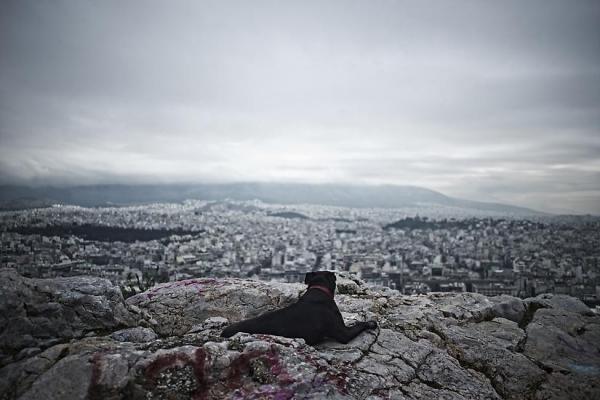Ελληνική Ύφεση: Αισθητική και Ιδεολογία στην αναπαράσταση της κρίσης στην Ελλάδα
Η ελληνική κρίση προβλήθηκε εκτενέστατα από τα παγκόσμια ειδησεογραφικά πρακτορεία, αντικαθιστώντας την θριαμβευτική και γεμάτη αίγλη οπτική αφήγηση που διατυμπανιζόταν μόλις πριν μία δεκαετία με αυτή μιας φτωχής, υπερχρεωμένης χώρας. Η εισήγηση επιχειρεί να παρουσιάσει πώς η ελληνική φωτογραφία έχει παρακολουθήσει την κρίση, όχι μόνο καταγράφοντας την, αλλά προσπαθώντας επίσης να την ερμηνεύσει, προτείνοντας τη διάκριση ανάμεσα σε τρεις προσεγγίσεις: την Τεκμηρίωση, την Ερμηνεία και την Ιστορικοποίηση.
Η Τεκμηρίωση αναφέρεται στην ακριβή καταγραφή των επιπτώσεων της κρίσης. Είτε εστιάζοντας στην παρακμή και τη στέρηση, είτε εξερευνώντας τον κοινωνικό αναβρασμό και το φασισμό, τα έργα αυτής της κατηγορίας παρέχουν αντιστικτικές αφηγήσεις και ποικίλες οπτικές, δίνοντας αισθητική έκφραση σε θεμελιώδεις ιδεολογικές προκλήσεις της Ελλάδας της κρίσης.
Η Ερμηνεία ενσωματώνει λιγότερο άμεσους τρόπους αναπαράστασης, και περιλαμβάνει έργα που συνδυάζουν ντοκουμέντο και τέχνη. Επιστρατεύοντας σύγχρονες στρατηγικές όπως το μεταμοντέρνο pastiche, την παρωδία, την οικειοποίηση ή τη σειριακότητα, τα έργα αυτά φιλοδοξούν να αποκτήσουν το καθεστώς κριτικής τέχνης καθώς και να καταγράψουν τη σύγχρονη εποχή και το εγχώριο περιβάλλον.
Η Ιστορικοποίηση, τέλος, είναι στενά συνδεμένη με το προηγούμενο είδος προσέγγισης, περιλαμβάνοντας έργα που στοχάζονται πάνω στην κρίση προσπαθώντας να δημιουργήσουν μια σφαιρική εικόνα ή/και να την ορίσουν μέσα σε ένα ευρύτερο ιστορικό και πολιτικό πλαίσιο που δεν περιορίζεται στο σύγχρονο. Σε όλα αυτά τα έργα, η μνήμη δεν νοείται απλώς ως ένα μέσο που αφορά αποκλειστικά το παρελθόν αλλά ως ένα μέσο ανά-παράστασης που συνδέεται πάντοτε με το παρόν.
Φωτογραφία: Δημήτρης Μιχαλακάκης, Burnout
The Greek Depression: Aesthetics and Ideology in the Representation of Crisis in Greece
The spectacle of Greek crisis was played out around the world news, replacing the victorious and glamorous visual narrative trumpeted only a decade ago with that of a poor, debt-laden country. This paper aims to present how Greek photography has kept pace with crisis, not only by chronicling it, but also trying to interpret it. To do so, it suggests we may distinguish between three different approaches to the crisis: Documentation, Interpretation and Historicization.
Documentation refers to the direct recording of the effects of the crisis. Either focusing on decadence and dispossession or exploring social upheaval and fascism, these projects offer contrapuntal narratives, and order multiple perspectives giving aesthetic expression to fundamental ideological challenges of Depression-era Greece.
Interpretation involves more askance and less direct ways of representation, and includes works combining documentary and art. Employing several contemporary strategies, such as postmodern pastiche, parody, appropriation or seriality, these are practices aspiring to attain the status of a critical art and to record the contemporary era and one’s own domestic environment.
Historicization derives from and is closely related to the latter kind of approach, and involves projects which reflect on the crisis from an ankle, trying to put it in perspective and/or consider it within a larger historical and political context which is not limited to the current one. In all these projects, memory is not thought as bounding us in some deep sense to past times but as mode of re-presentation and as belonging ever more to the present.
Photo: Dimitris Michalakakis, Burnout

